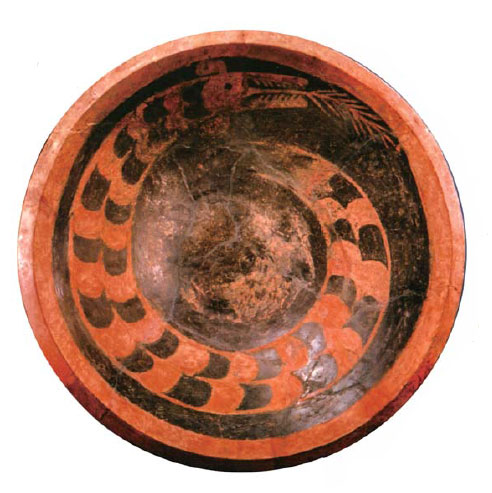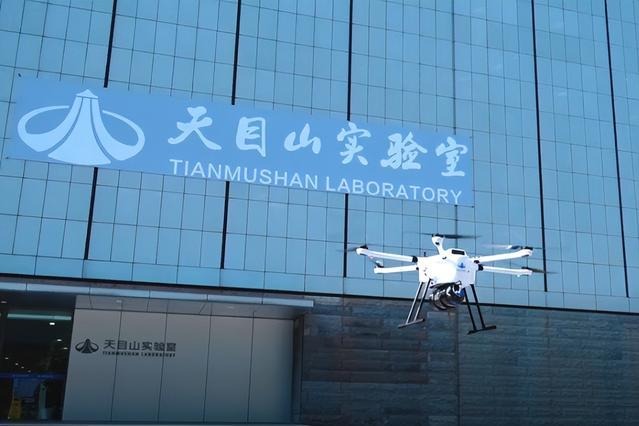Finding a lost city

Was Taosi the source of Chinese civilization? An excavation report poses the question with ample text and photos
The remains of what could be the birthplace of the Chinese civilization - pending further archaeological studies - were unearthed to an extent in North China earlier this year after a three-decade excavation. And the first part of a report covering the excavation activities from 1978 to 1985 was released on Dec 12.
Spread across 2.8 square kilometers, in Shanxi province's Linfen city, the relics of Taosi, thought to be 4,300 years old, are presented in words and more than 500 photos in the voluminous report by the Chinese Academy of Social Sciences, the top government think-tank of its kind.
| Above: An aerial view of the archaeological site of Taosi, which is thought to be the origin of Chinese civilization, in Linfen, Shanxi province. Below: Significant relics unearthed in Taosi include a painted pottery plate, which features the pattern of a dragon. Photos Provided to China Daily |

Taosi may have been Emperor Yao's capital that was abandoned around the 19th century BC.
While the first draft of the report was written in the early 1990s, data scrutiny and updating of the findings at the site continues.
Yao's rule is estimated to have started in 23rd century BC, with some of his legends figuring in Records of the Grand Historian, also known as "Shiji", a book from the first century BC. But little archaeological evidence of his rule had been found until excavations in Shanxi began in recent decades.
"The appearance of a city surrounded by high halls is symbolic of the birth of a civilization," says Bai Yunxiang, deputy director of the Institute of Archaeology, an affiliate of the Chinese Academy of Social Sciences.
"We've found other city relics in China that existed earlier than Taosi. However, none of them have the clear layouts and structures of palaces that Taosi has.
"Taosi is the earliest capital-level city ever unearthed in China," he tells China Daily.
Bai says a rigid chain of evidence is necessary to make an archaeological deduction. Some Chinese archaeologists say Taosi culture began from the 23rd century BC, coinciding with Yao's time.
Historical records suggest Yao's regime may have been in today's Linfen. Cultural relics with inscriptions of his rule have been found among the relics.
The report focuses on the discovery of complexes with more than 1,000 tombs in Taosi, dug out before 1985. The tombs also hint at the existence of social stratification in ancient times, Bai says.
But the tombs have yet to offer "concrete" evidence that Taosi was indeed Yao's capital, he adds.
The relics have helped archaeologists understand society at the time and have created a strong foundation for excavations since 1999.
In 2003, an observatory believed to have been built around the 21st century BC was unearthed in Linfen as proof of a highly developed civilization, even preceding Stonehenge.
"It is estimated to be the world's earliest observatory with a mature calendar system," says He Nu, chief of Taosi's relic-excavation team. "But we still need further research on details."
Earlier, his team studied a solar calendar found at the site for a year. The calendar is likely the world's earliest as well, he says.
More recent discoveries seem to support the hypothesis that Yao used Taosi as his capital. For example, the structure of que, a freestanding, ceremonial gate tower in traditional Chinese-palace construction, was unearthed earlier this year in Taosi. It resembles the entrance of the Forbidden City in Beijing, He says.
"The handicraft industry we found among the relics also doesn't look like it was run by clans, but rather by powerful rulers."
Nevertheless, many experts associated with the project say more studies are necessary before coming to conclusions about Taosi. Old history textbooks say the first Chinese dynasty belonged to the Xias, who ruled from the 21st century BC, and could have descended from Yao's successors, but there is almost no archaeological proof to support the theory yet.
Song Xinchao, deputy director of the State Administration of Cultural Heritage, says it's too early for archaeologists to celebrate.
Though similarities between character-like "scripts" of Taosi and oracle-bone scripts of later times have been found, the formation process remains unclear, Song says, calling for more comprehensive and interdisciplinary research.
"The major city relics in North China should not be studied in isolation while looking for the larger picture of the origin of Chinese civilization," says Zhao Hui, a history professor from Peking University.
"As the most important participants forming that civilization, the whole region should be studied to find connections among different sets of relics."
In imperial China, ruling dynasties preferred centralization of authority, based on an agrarian economy, according to He, the excavation-team leader. That is a probable reason why Chinese people tend to agree that their civilization was born in an area along the Yellow River, with agriculture as the dominant force.
Remains of ancient cities discovered along the Yangtze River, like Liangzhu in Zhejiang province, suggested these settlements were more focused on commerce.
But since commerce-based economy failed in ancient China, such relics couldn't be considered symbols of the origin of Chinese civilization, he says.
wangkaihao@chinadaily.com.cn
(China Daily European Weekly 12/18/2015 page25)
Today's Top News
- China remembers victims of Nanjing Massacre, 88 years on
- New plan will be a road map for a stronger future
- Taiwan's character of the year a vote against confrontation
- Strengthened resilience key for economy
- Video sheds new light on Japan's wartime atrocities
- Xi: World yearns for peace, trust more than ever































